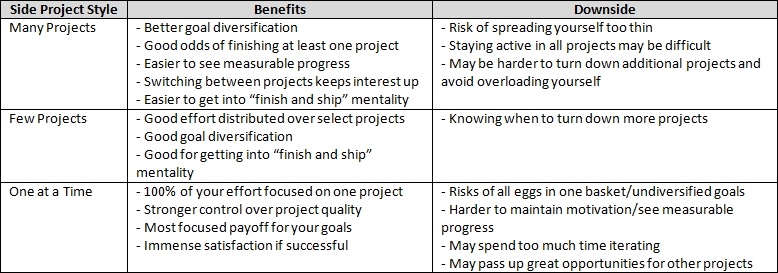Maximizing Your Side Project Success

If you’re involved in the game industry in any way, chances are you share a gift common to most developers: enthusiastic proactivity. The competitive nature and innate complexity of learning how to make digital games all but requires not only genuine enthusiasm for your projects, but the wherewithal to see them to completion.
Yet regardless of whether you’re a student looking to break in or a veteran developer pursuing your personal vision on the weekends, taking a careful, measured approach to your side projects can help make the difference between a legion of unfinished prototypes and a few finished masterworks.
Identify Your Mountain
“Something that worked for me was imagining that where I wanted to be… was a mountain. A distant mountain. My goal. … And I knew that as long as I kept walking towards the mountain I would be all right. And when I truly was not sure what to do, I could stop, and think about whether it was taking me towards or away from the mountain.” – Neil Gaiman
The above excerpt from famed author Neil Gaiman’s 2012 commencement address at The University of the Arts may be referring to career development, but it also applies to strategically selecting which side projects are worth undertaking.
When evaluating whether to tackle a new project, take a step back and assess where this project fits in with your personal goals with games and game development.
Is your primary goal for taking on a new project right now to:
- Gain general game development experience?
- Create material to fill out your portfolio?
- Create commercial releases to make money?
- Enter game development contests for prize money, recognition or exposure?
- Learn how to use a specific tool or framework?
- Just have fun for the sake of doing it?
When you have your answer, ask yourself: Does this project get me closer to the mountain, or does it take me farther away?
If it’s a group project, are everybody’s goals aligned? This may not appear to matter at first, but for longer-term projects, conflicting goals could lead to conflicting decisions once everybody’s made the investment of time and money in the game.
Know Your Side Project Style
Do you thrive on multitasking and constant activity? Can you only focus on a few projects at once without letting anything slip through the cracks? Or do you do your best work when saddling up to one assignment at a time, blocking out all distractions?
Knowing which side project style suits you best is key information in how you allocate time to your side projects. While this may seem to be common sense, and on some level you may already know which type of work style suits you best, actually acknowledging this as your peak working configuration and managing your side projects accordingly is a whole other step that many overlook.
Here’s a totally unscientific breakdown of some benefits and downsides of each side project style. I’m sure there are plenty of items missing, but here’s a start:

I’ve found that I work best on a few projects at a time, but this is an interesting mix of personality, skillset, experience, attention span, people skills (for group projects) and a thousand other variables.
If lately you’re finding your side projects are stalling or aren’t up to the standards you expect from yourself, it could be worthwhile to examine what your natural side project style is and how it compares to your current project workload.
It’s OK to Say Go Away (For Now)
For some people, the hardest word to say is “no.” Maybe your friends are starting up a new project they’re excited about, or your game dev hero reached out specifically to you to work on something. If, upon reflecting on their motivations and your current goals, this project would ultimately take you farther away from the mountain, and you don’t have the time and energy to spare, you have to say no… for now. Make sure to leave the door open to revisit a collaboration in the future, because we’re all busy, and hey! These are side projects anyway.
If, on the other hand, you wake up with a start in the middle of the night with a brilliant idea, only to see that it’s merely neat in the light of day, you can also say “no” to yourself… again, for now. Keep every crappy idea you come up with in a notebook or a file somewhere for later (hypothetically), and you’ll release any hold it may have on your subconscious so you’re free to work on other things.
Like the works of passion they are, side projects live and die based on two resources: time and enthusiasm. Finding the best way to maximize your enthusiasm for your side projects will help give them the shot they deserve at becoming happy, successful, finished games.
